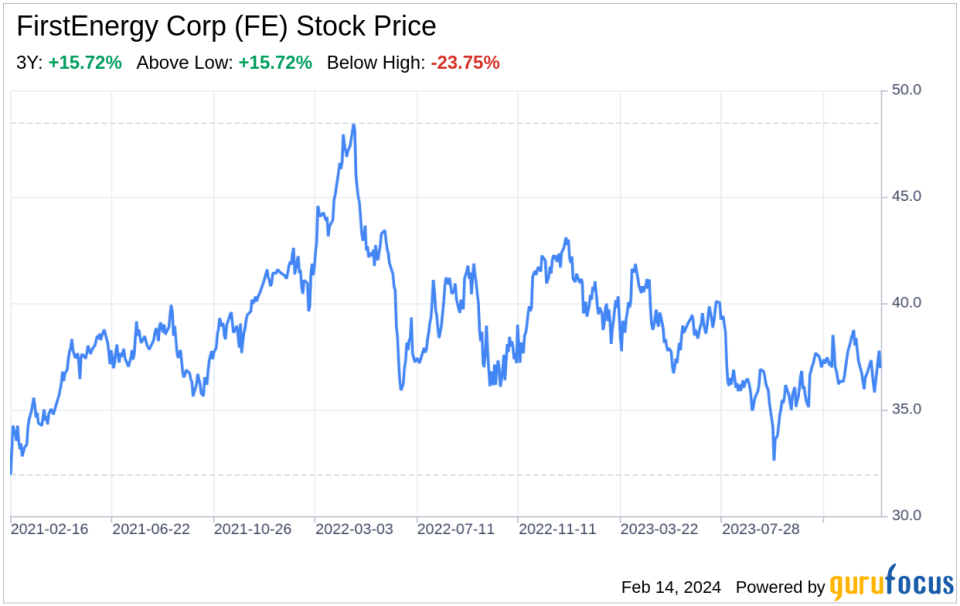Decoding FirstEnergy Corp (FE): A Strategic SWOT Insight
FirstEnergy Corp's robust transmission system and regulated distribution utilities highlight its strong market presence.
Supply chain challenges and competition in transmission projects pose potential risks.
Strategic initiatives in cybersecurity and human capital management showcase proactive adaptation.
Emerging environmental regulations and market competition present ongoing challenges.
On February 13, 2024, FirstEnergy Corp (NYSE:FE), an investor-owned holding company with a significant footprint in the electric utility industry, filed its 10-K with the SEC. This SWOT analysis delves into the intricacies of the filing, providing a financial overview and a strategic evaluation of the company's position. With a regulated distribution network across six states and one of the largest electric transmission systems in the nation, FirstEnergy serves over six million customers. The financial tables from the filing reveal a company with a solid base of regulated electric generation capacity and a commitment to meeting the electricity demands of its service territories. As we dissect the filing, we will explore the strengths, weaknesses, opportunities, and threats that shape FirstEnergy's operational and financial landscape.

Strengths
Regulated Distribution and Transmission System: FirstEnergy's regulated distribution segment, which distributes electricity through its utility operating companies, is a cornerstone of its strength. The company controls 3,580 MWs of regulated electric generation capacity, primarily in West Virginia and Virginia. This capacity, coupled with a vast transmission system of over 24,000 miles, positions FirstEnergy as a key player in the regions it serves. The company's ability to reliably deliver power under state-regulated rate tariffs solidifies its market presence and provides a stable revenue stream.
Human Capital and Safety Initiatives: FirstEnergy places a high emphasis on human capital, with a workforce of 12,042 employees, approximately 45% of whom are represented by unions. The company's focus on safety, diversity, equity, inclusion (DEI), and workplace flexibility demonstrates its commitment to fostering a positive work environment. These initiatives not only enhance employee engagement and satisfaction but also contribute to operational efficiency and a strong corporate culture, which are critical assets in a competitive industry.
Weaknesses
Supply Chain Vulnerabilities: The 10-K filing highlights supply chain vulnerabilities that have emerged in the post-pandemic economy, with increased lead times and costs due to labor shortages and raw material availability. While FirstEnergy has taken steps to mitigate these risks, such as expanding its supply base and enhancing demand management, the potential for prolonged disruptions could adversely affect the company's operations, cash flow, and financial condition. This weakness underscores the need for continued strategic planning to navigate an uncertain supply chain landscape.
Competition in Transmission Projects: FirstEnergy faces competition for transmission projects within the PJM Region due to FERC's Order No. 1000, which allows non-incumbent developers to compete for certain projects. This regulatory change introduces a new competitive dynamic that could impact FirstEnergy's ability to secure future transmission projects, potentially affecting its growth trajectory and market share in the transmission sector.
Opportunities
Strategic Cybersecurity Enhancements: FirstEnergy's comprehensive cybersecurity program, aligned with national standards, represents a significant opportunity to strengthen its market position. The company's multi-layered governance structure, regular risk assessments, and third-party security partnerships are proactive measures that not only protect against cyber threats but also build trust with customers and stakeholders. As cyber threats continue to evolve, FirstEnergy's strategic focus on cybersecurity can serve as a differentiator in the industry.
Advancements in DEI and Employee Development: The company's initiatives to promote DEI and employee development are opportunities to attract and retain top talent. By enhancing transparency in DEI data, improving talent processes, and offering programs like "Educate to Elevate," FirstEnergy is positioning itself as an employer of choice. These efforts can lead to a more innovative, responsive, and customer-focused organization.
Threats
Environmental Regulation Impact: Increased environmental regulations pose a threat to FirstEnergy's fuel supply and operational costs. The company's reliance on coal contracts and emission allowances necessitates careful management to meet regulatory requirements. Changes in environmental policies could lead to additional compliance costs or operational constraints, impacting profitability and strategic flexibility.
Seasonality and Weather Patterns: The seasonal nature of the electric power industry, with peak demand during summer and winter, exposes FirstEnergy to weather-related risks. Unpredictable weather patterns can result in fluctuating power sales, revenues, and cash flow. This threat highlights the importance of strategic planning and operational resilience to mitigate the impact of mild weather conditions on the company's financial performance.
In conclusion, FirstEnergy Corp (NYSE:FE) exhibits a strong market presence through its regulated distribution and transmission system, bolstered by a focus on human capital and safety. However, supply chain vulnerabilities and competition in transmission projects present challenges that require strategic attention. Opportunities for growth lie in cybersecurity enhancements and employee development initiatives. Meanwhile, environmental regulations and the inherent seasonality of the industry pose ongoing threats. By leveraging its strengths and addressing its weaknesses, FirstEnergy can capitalize on opportunities and navigate threats in the evolving electric utility landscape.
This article, generated by GuruFocus, is designed to provide general insights and is not tailored financial advice. Our commentary is rooted in historical data and analyst projections, utilizing an impartial methodology, and is not intended to serve as specific investment guidance. It does not formulate a recommendation to purchase or divest any stock and does not consider individual investment objectives or financial circumstances. Our objective is to deliver long-term, fundamental data-driven analysis. Be aware that our analysis might not incorporate the most recent, price-sensitive company announcements or qualitative information. GuruFocus holds no position in the stocks mentioned herein.
This article first appeared on GuruFocus.
